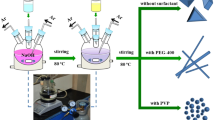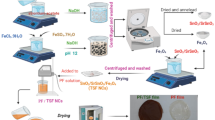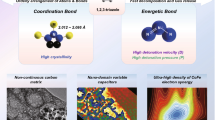Abstract
Metal-organic framework (MOF) crystals have promising applications in a number of different fields, but the growth of MOF crystals with controllable morphology and high uniformity remains a major challenge. By taking the advantage of the synergistic effects of water molecules in the mixed solvent and polyvinylpyrrolidone (PVP) surfactants, this work demonstrates an approach for the preparation of NH2-MIL-88B(Fe) MOF crystals with both highly customizable size and aspect ratios and high uniformity. The effects of the concentration of water in the mixed solvent and the amount of PVP surfactants on the morphology and size of the MOF crystals were investigated. The morphology and crystalline properties were characterized by scanning electron microscopy and X-ray diffraction techniques. The data showed that through controlling the concentration of water in the solvent and the amount of the PVP surfactant, the size of the MOF crystals can be tuned rather widely, over 344–5.14 μm, while the aspect ratio of the crystals can be varied widely over 1.0–7.1. Possible mechanisms for such high tunability were discussed. As an example of potential applications, the complex permeability and permittivity of MOF-derived composites (25 wt%) were measured over a wide frequency range of 2–18 GHz. The parameters were then used to evaluate the potential for electromagnetic wave absorption. The results indicate that the composite with a thickness of only 1.2 mm exhibits a “− 10 dB” absorption bandwidth of 4.1 GHz and a minimum reflection of − 20 dB. Such bandwidth and reflection properties provide inspiration for future design of lightweight, broadband electromagnetic wave absorbers from the perspective of fine morphology control.







Similar content being viewed by others
Data availability
The data that support the findings of this study are available from the corresponding author upon reasonable request.
References
O.M. Yaghi, G. Li, H. Li, Selective binding and removal of guests in a microporous metal–organic framework. Nature. 378, 703–706 (1995)
N. Stock, S. Biswas, Synthesis of metal-organic frameworks (MOFs): routes to various MOF topologies, morphologies, and composites. Chem. Rev. 112, 933–969 (2012)
L. Jin, Q. Liu, W. Sun, An introduction to synthesis and application of nanoscale metal–carboxylate coordination polymers. CrystEngComm 16, 3816–3828 (2014)
A. Wei Xia, R. Mahmood, Q. Zou, Xu, Metal–organic frameworks and their derived nanostructures for electrochemical energy storage and conversion. Energ. Environ. Sci. 8, 1837–1866 (2015)
Y. Cui, B. Li, H. He, W. Zhou, B. Chen, G. Qian, Metal–organic frameworks as platforms for functional materials. Accounts Chem. Res. 49, 483–493 (2016)
A.H. Assen, Y. Belmabkhout, K. Adil, A. Lachehab, H. Hassoune, H. Aggarwal, Advances on CO2 storage. Synthetic porous solids, mineralization and alternative solutions. Chem. Eng. J. 419, 129569 (2021)
D. Alezi, Y. Belmabkhout, M. Suyetin, P.M. Bhatt, ŁJ. Weseliński, V. Solovyeva, K. Adil, I. Spanopoulos, P.N. Trikalitis, A.-H. Emwas, M. Eddaoudi, MOF crystal chemistry paving the way to gas storage needs: aluminum-based soc-MOF for CH4, O2, and CO2 storage. J. Am. Chem. Soc. 137, 13308–13318 (2015)
Y. Zhang, C. Wang, T. Zhu, P. Wang, S. Gao, Ultra-high uptake and selective adsorption of organic dyes with a novel polyoxomolybdate-based organic–inorganic hybrid compound. RSC Adv. 5, 45688–45692 (2015)
X. Dai, Yu. Cao, X. Shi, X. Wang, The PLA/ZIF-8 nanocomposite membranes: the diameter and surface roughness adjustment by ZIF‐8 nanoparticles, high wettability, improved mechanical property, and efficient oil/water separation. Adv. Mater. Interfaces 3, 1600725 (2016)
B. Li, Y. Zhang, D. Ma, Lu. Li, G. Li, G. Li, Z. Shi, S. Feng, A strategy toward constructing a bifunctionalized MOF catalyst: post-synthetic modification of MOFs on organic ligands and coordinatively unsaturated metal sites. Chem. Commun. 48, 6151–6153 (2012)
C.I. Ezugwu, B. Mousavi, M.A. Asrafa, A. Mehta, H. Vardhanab, F. Verpoort, An N-heterocyclic carbene based MOF catalyst for Sonogashira cross-coupling reaction. Catal. Sci. Technol. 6, 2050–2054 (2016)
L. Gao, Q. Chen, T. Gong, J. Liu, C. Li, Recent advancement of imidazolate framework (ZIF-8) based nanoformulations for synergistictumor therapy. Nanoscale 11, 21030–21045 (2019)
C. Sun, C. Qin, X. Wang, G. Yang, K. Shao, Y. Lan, Z. Su, P. Huang, C. Wang, E. Wang, Zeolitic imidazolate framework-8 as efficient pH-sensitive drug delivery vehicle. Dalton T 41, 6906–6909 (2012)
C. Wang, H. Fu, P. Wang, C. Wang, Highly sensitive and selective detect of p-arsanilic acid with a new water-stable europium metal–organic framework. Appl. Organomet. Chem. 33, e5021 (2019)
X. Zhang, G. Ji, W. Liu, B. Quan, X. Liang, C. Shang, Y. Chenga, Y. Du, Thermal conversion of an Fe3O4@ metal–organic framework: a new method for an efficient Fe–Co/nanoporous carbon microwave absorbing material. Nanoscale 7, 12932–12942 (2015)
N.R. Sadegh Dehghani, S. Alam, T. Shahriarian, S. Mortezazadeh, A. Haghgoo, B. Golmohamadpour, M. Majidi, Khoobi, The effect of size and aspect ratio of Fe-MIL-88B-NH2 metal-organic frameworks on their relaxivity and contrast enhancement properties in MRI: in vitro and in vivo studies. J. Nanopart. Res. 20, 1–16 (2018)
T. Rodenas, I. Luz, G. Prieto, B. Seoane, H. Miro, A. Corma, F. Kapteijn, F.X. Llabrés i Xamena, J. Gascon, Metal-organic framework nanosheets in polymer composite materials for gas separation. Nat. Mater. 14, 48–55 (2015)
H. Vinh-Thang, S. Kaliaguine, Predictive models for mixed-matrix membrane performance: a review. Chem. Rev. 113, 4980–5028 (2013)
Z. Lars Heinke, C. Gu, Wöll, The surface barrier phenomenon at the loading of metal-organic frameworks. Nat. Commun. 5, 1–6 (2014)
T. Chalati, P. Horcajada, R. Gref, P. Couvreura, C. Serre, Optimisation of the synthesis of MOF nanoparticles made of flexible porous iron fumarate MIL-88A. J. Mater. Chem. 21, 2220–2227 (2011)
P. Horcajada, T. Chalati, C. Serre, B. Gillet, C. Sebrie, T. Baati, J.F. Eubank, D. Heurtaux, P. Clayette, C. Kreuz, J. Chang, Y. KyuHwang, V. Marsaud, P.-N. Bories, L. Cynober, S. Gil, G. Férey, P. Couvreur, R. Gref, Porous metal–organic-framework nanoscale carriers as a potential platform for drug delivery and imaging. Nat. Mater. 9, 172–178 (2010)
K.M.L. Taylor, A. Jin, W. Lin, Surfactant-assisted synthesis of nanoscale gadolinium metal-organic frameworks for potential multimodal imaging. Angew. Chem. Int. Edit. 47, 7722–7725 (2008)
O. Friščić, D.G. Reid, I. Halasz, R.S. Stein, R.E. Dinnebier, M.J. Duer, Ion-and liquid-assisted grinding: improved mechanochemical synthesis of metal–organic frameworks reveals salt inclusion and anion templating. Angew. Chem. 122, 724–727 (2010)
X. Cai, J. Lin, M. Pang, Facile synthesis of highly uniform Fe-MIL-88B particles. Cryst. Growth Des. 16, 3565–3568 (2016)
T. Tsuruoka, S. Furukawa, Y. Takashima, K. Yoshida, S. Isoda, S. Kitagawa, Nanoporous nanorods fabricated by coordination modulation and oriented attachment growth. Angew. Chem. 121, 4833–4837 (2009)
J. Hwang, T. Heil, M. Antonietti, B.V.K.J. Schmidt, Morphogenesis of metal–organic mesocrystals mediated by double hydrophilic block copolymers. J. Am. Chem. Soc. 140, 2947–2956 (2018)
X. Wang, S. Ma, D. Sun, S. Parkin, H. Zhou, A mesoporous metal—organic framework with permanent porosity. J. Am. Chem. Soc. 128, 16474–16475 (2006)
Z. Zhao, H. Li, K. Zhao, L. Wang, Microwave-assisted synthesis of MOFs: rational design via numerical simulation. Chem. Eng. J. 428, 131006 (2022)
L. Shao, Z. Yu, X. Li, X. Li, H. Zeng, X. Feng, Carbon nanodots anchored onto the metal-organic framework NH2-MIL-88B(Fe) as a novel visible light-driven photocatalyst: photocatalytic performance and mechanism investigation. Appl. Surf. Sci. 505, 144616 (2020)
S. Yixuan Gao, Y.Y. He, Y. Fan, L. Zhang, J. Ma, R. Hou, L. Chen, J. Chen, A photo-fenton self-cleaning membrane based on NH2-MIL-88B(Fe) and graphene oxide to improve dye removal performance. J. Membrane Sci. 626, 119192 (2021)
C. Hasirci, O. Karaagac, H.H. Kockar, Superparamagnetic zinc ferrite: a correlation between high magnetizations and nanoparticle sizes as a function of reaction time via hydrothermal process. J. Magn. Magn. Mater. 474, 282–286 (2019)
F. Ozel, H. Kockar, S. Beyaz, O. Karaagac, T. Tanrisever, Superparamagnetic iron oxide nanoparticles: effect of iron oleate precursors obtained with a simple way. J. Mater. Sci. 24(8), 3073–3080 (2013)
W. Zhao, J. Rong, W. Luo, L. Long, X. Yao, Enhancing the K-poisoning resistance of CeO2-SnO2 catalyst by hydrothermal method for NH3-SCR reaction. Appl. Surf. Sci. 579, 152176 (2022)
Y. Bai Sun, W. Liu, J. Zhao, P. Wu, Chen, Hydrothermal preparation and white-light-controlled resistive switching behavior of BaWO4 nanospheres. Nano-Micro Lett. 7(1), 80–85 (2015)
H. Bai Sun, L. Li, P. Wei, Chen, Hydrothermal synthesis and resistive switching behaviour of WO3/CoWO4 core–shell nanowires. CrystEngComm 16(42), 9891–9895 (2014)
M. Takashi Uemura, S. Ohba, Kitagawa, Size and surface effects of Prussian blue nanoparticles protected by organic polymers. Inorg. Chem. 43, 7339–7345 (2004)
M.-H. Pham, G.-T. Vuong, A.-T. Vu, D. Trong-On, Novel route to size-controlled Fe–MIL-88B–NH2 metal–organic framework nanocrystals. Langmuir 27, 15261–15267 (2011)
X. Cheng, A. Zhang, K. Hou, M. Liu, Y. Wang, C. Song, G. Zhang, X. Guo, Size-and morphology-controlled NH2-MIL-53 (Al) prepared in DMF–water mixed solvents. Dalton 42, 13698–13705 (2013)
J. Weihua Gu, B. Lv, X. Quan, B. Liang, G. Zhang, Ji, Achieving MOF-derived one-dimensional porous ZnO/C nanofiber with lightweight and enhanced microwave response by an electrospinning method. J. Alloy Compd. 806, 983–991 (2019)
B. Zhang, J. Wang, J. Wang, S. Huo, B. Zhang, Y. Tang, Microwave absorption properties of lightweight absorber based on Fe50Ni50-coated poly (acrylonitrile) microspheres and reduced graphene oxide composites. J. Magn. Magn. Mate 413, 81–88 (2016)
F. Chen, S. Zhang, B. Ma, Y. Xiong, H. Luo, Y. Cheng, X. Li, X. Wang, R. Gong, Bimetallic CoFe–MOF@ Ti3C2TxMXene derived composites for broadband microwave absorption. Chem. Eng. J. 431, 134007 (2022)
T. Uemura, S. Kitagawa, Prussian blue nanoparticles protected by poly (vinylpyrrolidone). J. Am. Chem. Soc. 125, 7814–7815 (2003)
S. Bauer, C. Serre, T. Devic, P. Horcajada, J.G. Marrot, N. Férey, Stock, High-throughput assisted rationalization of the formation of metal organic frameworks in the iron (III) aminoterephthalate solvothermal system. Inorg Chem. 47(17), 7568–7576 (2008)
M. Ma, A. Bétard, I. Weber, N.S. Al-Hokbany, R.A. Fischer, N. Metzler-Nolte, Iron-based metal–organic frameworks MIL-88B and NH2-MIL-88B: high quality microwave synthesis and solvent-induced lattice “breathing.” Cryst. Growth Des. 13(6), 2286–2291 (2013)
C. Qiao, R. Zhang, Y. Wang, Q. Jia, X. Wang, Z. Yang, T. Xue, R. Ji, X. Cui, Z. Wang, Rabies virus-inspired metal-organic frameworks (MOFs) for Targeted imaging and chemotherapy of glioma. Angew. Chem. Int. 59(39), 16982–16988 (2020)
Funding
This work is supported by the grants from National Natural Science Foundation of China (Grant No. 61971459).
Author information
Authors and Affiliations
Contributions
JL: Conceptualization, methodology, validation, writing—original draft. JY: Formal analysis, investigation. SA: Investigation. MW: Formal analysis, investigation. XW: Data curation visualization, supervision. RG: Formal analysis, investigation, resources. YN: Validation, writing—review & editing, funding acquisition.
Corresponding author
Ethics declarations
Conflict of interest
The authors declare that they have no known competing financial interests or personal relationships that could have appeared to influence the work reported in this paper.
Additional information
Publisher’s note
Springer Nature remains neutral with regard to jurisdictional claims in published maps and institutional affiliations.
Rights and permissions
About this article
Cite this article
Liu, J., Yang, J., An, S. et al. Synthesis and electromagnetic properties of NH2-MIL-88B(Fe) crystals with morphology and size controllable through synergistic effects of surfactant and water. J Mater Sci: Mater Electron 33, 14228–14239 (2022). https://doi.org/10.1007/s10854-022-08351-1
Received:
Accepted:
Published:
Issue Date:
DOI: https://doi.org/10.1007/s10854-022-08351-1




